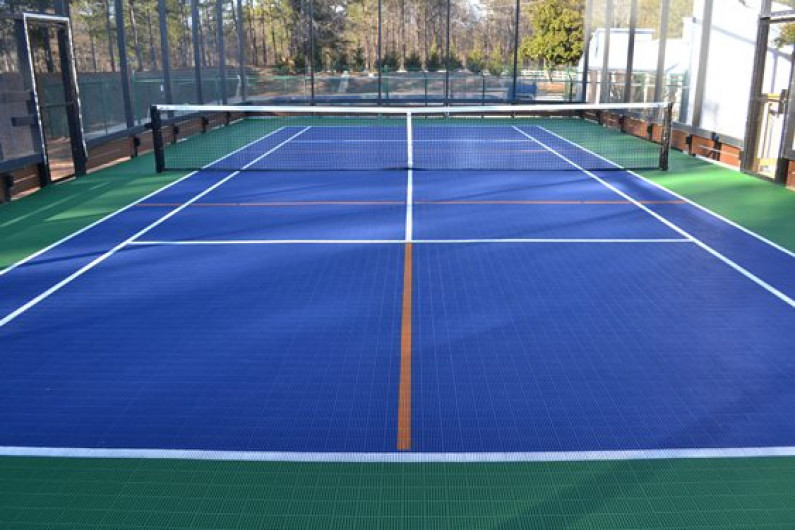Indoor and Exterior Pickleball Court Construction Solutions
Indoor and Exterior Pickleball Court Construction Solutions
Blog Article
Lasting Practices in Pickleball Court Building And Construction You Should Know
As the appeal of pickleball proceeds to increase, so as well does the need for sustainable practices in court building and construction. This strategy not just addresses ecological problems yet likewise enhances the long life and performance of the courts. From choosing environment-friendly materials to executing reliable drain and energy-saving lighting remedies, there are various strategies to take into consideration. Yet, the influence of these practices expands far past the court itself. Recognizing exactly how each aspect adds to a much more lasting future invites further exploration right into the complex equilibrium in between recreational growth and ecological stewardship.
Selecting Eco-Friendly Materials
Picking environmentally friendly products is a critical step in the building of lasting pickleball courts. The choice of sustainable materials not only minimizes environmental impact yet additionally boosts the longevity and efficiency of the court. Key products consist of recycled rubber for the surface area, which supplies superb resilience and shock absorption while drawing away waste from land fills.
In addition, utilizing in your area sourced products decreases transport exhausts and supports regional economic climates. Pickleball court construction. Utilizing native woods for fence and seats can supply a sustainable visual while making sure resilience versus the elements.
Including absorptive products for court foundations can additionally contribute to sustainability by enabling natural water drain and decreasing drainage. These options not just protect neighborhood ecological communities however also promote much healthier play environments.
Effective Drainage Solutions
While the choice of eco-friendly materials is essential, carrying out efficient drain solutions is similarly essential for maintaining lasting pickleball courts. Correct water drainage not only safeguards the court surface area from water damages yet additionally reduces disintegration and drainage, advertising ecological honesty.
Reliable water drainage systems can include absorptive paving, which permits water to penetrate the ground rather than pooling on the surface. This minimizes the probability of standing water, which can bring about mold and mildew and various other maintenance problems. Additionally, incorporating tactically put water drainage networks and swales can guide excess water away from the court area, making sure a dry playing surface and preventing dirt disintegration.
Making use of indigenous plants in the landscape design around the courts can even more enhance drainage by absorbing excess water and decreasing runoff. These plants require less watering and promote biodiversity, aligning with lasting methods.
In addition, it is crucial to on a regular basis maintain the water drainage system to ensure its lasting efficiency. This includes cleaning debris and tracking for blockages. By prioritizing efficient drain services, pickleball court manufacturers can substantially add to the sustainability and longevity of the center, ultimately benefiting both gamers and the environment.
Energy-Efficient Illumination Options
As the need for pickleball remains to expand, incorporating energy-efficient lighting choices right into court design has come to be increasingly essential for sustainability. Typical lighting systems typically consume extreme energy, adding to higher operational expenses and ecological influence. Therefore, adopting modern, energy-efficient technologies is vital for both brand-new buildings and improvements.
LED (Light Emitting Diode) illumination sticks out as a top option because of its long life and energy financial savings (Pickleball court construction). Contrasted to conventional lighting, LEDs use approximately 75% much less power and can last as much as 25 times longer, substantially decreasing maintenance prices. The directional nature of LED lighting decreases light air pollution, guaranteeing More about the author that lighting is concentrated on the court rather than bordering areas.

Lasting Surface Area Alternatives
Discovering sustainable surface area options for pickleball courts has actually gotten grip among home builders and players alike. The emphasis on environmentally friendly materials not only straightens with the growing ecological understanding yet also improves the efficiency and resilience of the courts.
This material supplies exceptional shock absorption, decreasing the threat of injuries for gamers while advertising sustainability. These ceramic tiles are simple to change and mount, and their convenience enables for various court arrangements.
Natural lawn courts are additionally emerging as a lasting option, advertising biodiversity and decreasing the warmth island result. site link However, they call for regular upkeep and water, which may not align with all sustainability objectives.

Water Preservation Methods

Another effective strategy includes the installation of rain harvesting systems. These systems accumulate and keep rainwater for usage in maintaining court surface areas and landscape design. This method not just conserves safe and clean water however also minimizes reliance on metropolitan resources.
Furthermore, using drought-resistant landscaping around the courts is essential. Indigenous plants call for less water and are much better adapted to neighborhood climate problems, thus reducing general water consumption. In addition, using reliable irrigation systems, such as drip irrigation, makes certain that water is delivered directly to plant origins, decreasing dissipation and waste.
Verdict
Integrating sustainable techniques in pickleball court building significantly adds to ecological conservation and source efficiency. Using eco-friendly materials, This Site executing efficient drain services, and embracing energy-efficient illumination choices can significantly minimize environmental effect. Checking out sustainable surface area options and utilizing water conservation strategies improve the general sustainability of these recreational centers. By focusing on these techniques, the building and construction of pickleball courts can line up with broader environmental goals while promoting long life and capability within neighborhoods.
As the appeal of pickleball continues to climb, so as well does the demand for sustainable techniques in court construction.Choosing green products is a crucial action in the building of sustainable pickleball courts. By prioritizing energy-efficient illumination alternatives, pickleball court builders can contribute to a more sustainable future while satisfying the needs of gamers and stakeholders alike.Integrating lasting surface area options not only improves the efficiency of pickleball courts yet additionally leads the method for carrying out efficient water conservation techniques.Incorporating lasting techniques in pickleball court building substantially contributes to environmental conservation and source efficiency.
Report this page